AUDI Q7 2014 Owner´s Manual
Manufacturer: AUDI, Model Year: 2014, Model line: Q7, Model: AUDI Q7 2014Pages: 340, PDF Size: 85.02 MB
Page 181 of 340
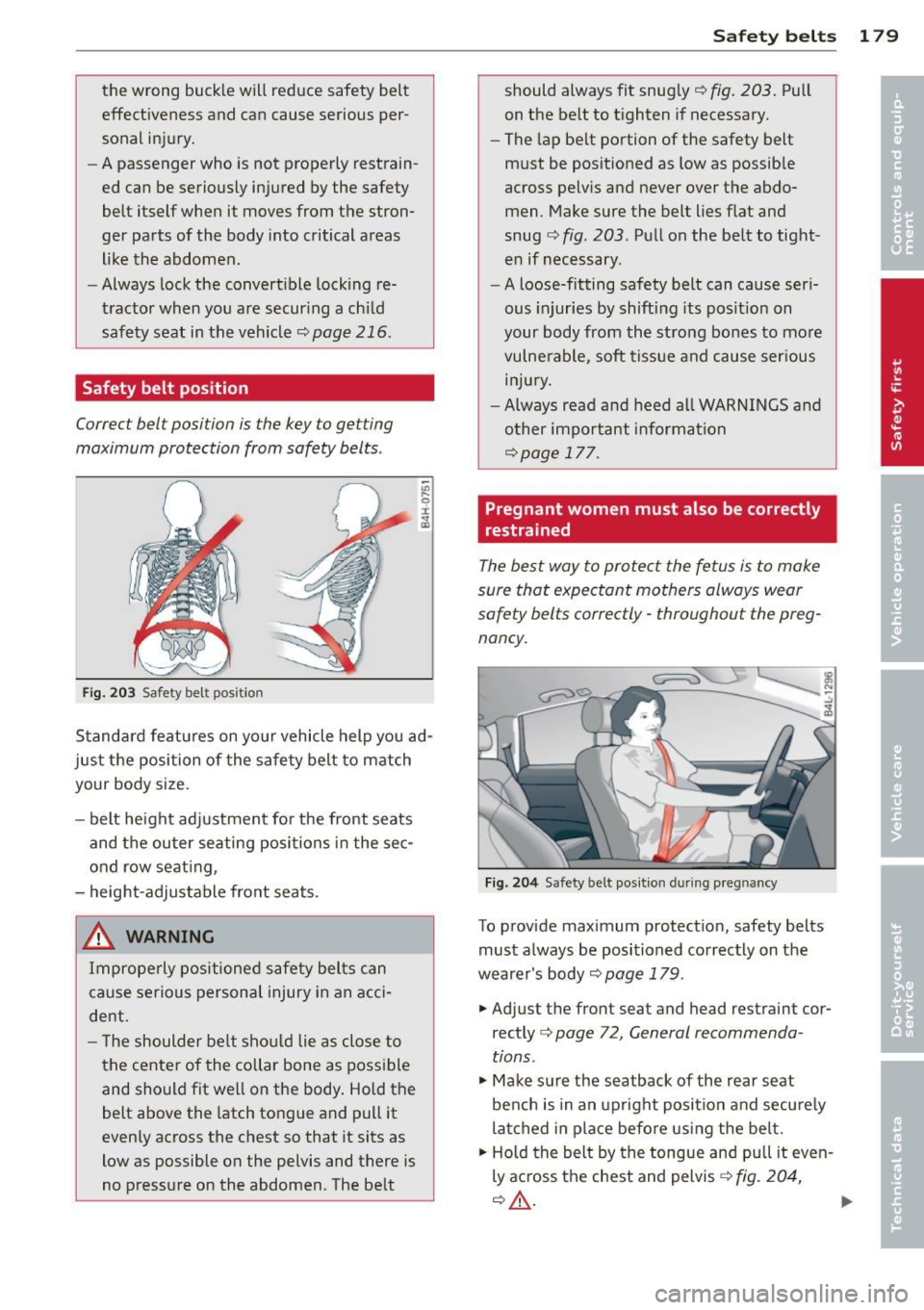
the wrong buckle will reduce safety belt
effectiveness and can cause serious per
sonal injury.
- A passenger who is not properly restrain
ed can be seriously injured by the safety
belt i tself when it moves from the stron
ger parts of the body into critical areas
like the abdomen .
- Always lock the convertible locking re
tractor when you are secur ing a child
safety seat in the vehicle~
page 216.
Safety belt position
Correc t bel t posi tion is the key to ge tting
maximum protection from safety belts .
Fig. 203 Safety belt pos it io n
Standard features on your vehicle help you ad
just the position of the safety belt to match
your body size.
- belt height adjustment for the front seats
and the outer seating positions in the sec
ond row seating,
- height-adjustable front seats.
A WARNING
Improperly positioned safety belts can
cause serious personal injury in an acci
dent.
-
- The shoulder belt should lie as close to
the center of the collar bone as possible
and should fit well on the body. Ho ld the
belt above the latch tongue and pull it
evenly across the chest so that it sits as
low as possible on the pelvis and there is
no pressure on the abdomen . The belt
Safety belts 179
should always fit snugly= fig. 203. Pull
on the belt to tighten if necessary.
- The lap belt portion of the safety belt
must be positioned as low as possible
across pelvis and never over the abdo
men . Make sure the belt lies flat and
snug ¢
fig. 203 . Pull on the belt to tight
en if necessary .
- A loose-fitting safety belt can cause seri
ous injuries by shifting its pos ition on
your body from the strong bones to more
vulnerable , soft tissue and cause serious
injury.
- Always read and heed all WARNINGS and
other important information
¢ page 177 .
Pregnant women must also be correctly
restrained
The best way to protect the fetus is to make
sure that expectant mothers always wear
saf ety belts correctly -throughout the preg
nancy.
Fig. 204 Safety belt pos ition du ring pregnan cy
To provide max imum protection, safety belts
must always be positioned correctly on the
wearer's body
¢ page 179 .
... Adjus t the fron t seat and head restra in t cor
rectly ¢
page 72, General recommenda
tions .
.,. Make sure the seatback of the rear seat
bench is in an upright position and securely
latched in place before using the belt.
... Hold the belt by the tongue and pu ll it even
ly across the chest and pelvis¢
fig. 204,
=A . ~
Page 182 of 340
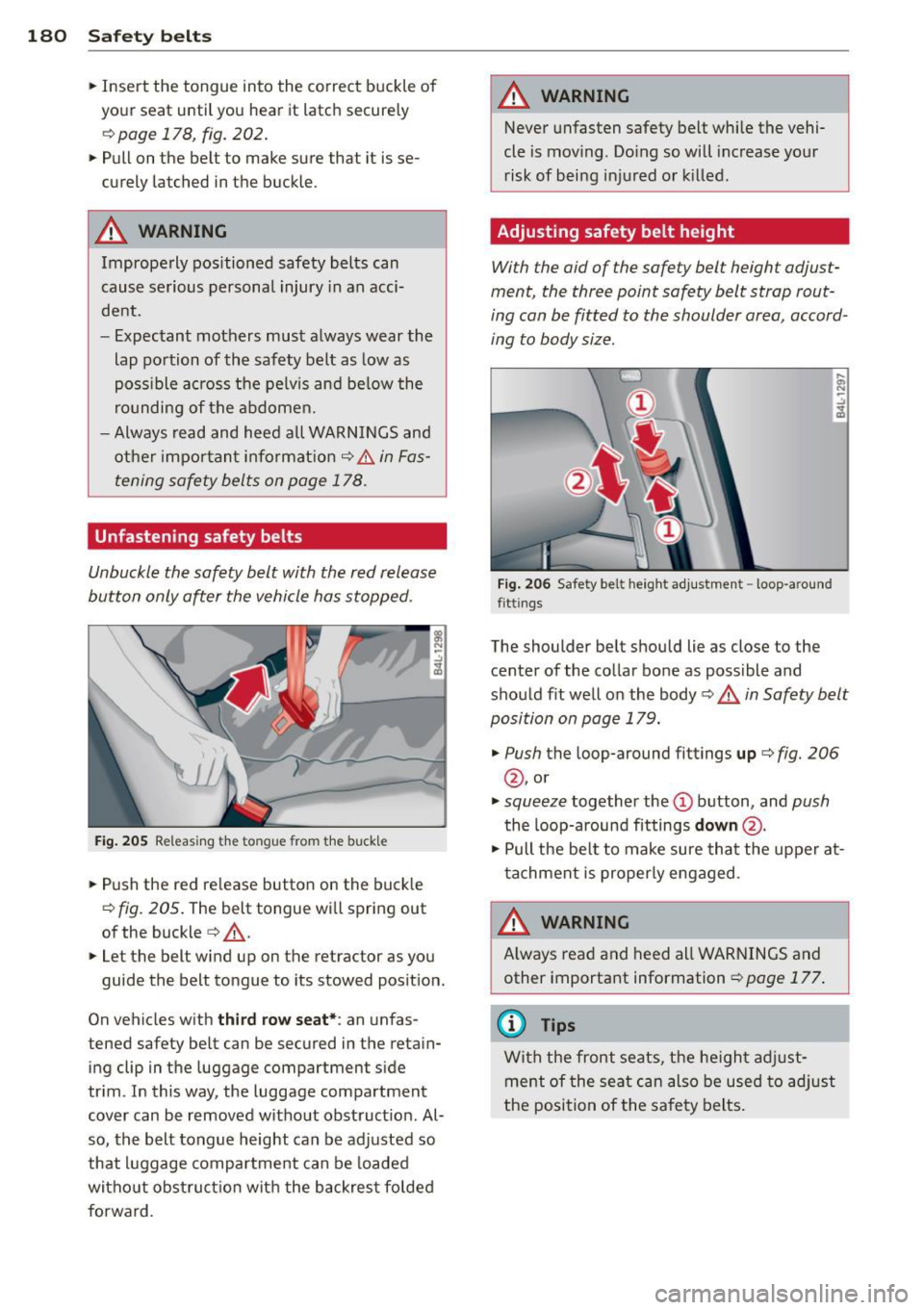
180 Safety belts
• Insert the tongue into the correct buckle of
your sea t until you hear it latch securely
¢ page 178, fig. 202.
•Pullon the belt to make sure that it is se
curely latched in the buckle .
A WARNING
Improperly positioned safety belts can
cause serious personal injury in an acci
dent.
- Expectant mothers must always wear the
lap portion of the safety belt as low as
possible across the pelv is and be low the
rounding of the abdomen.
- Always read and heed all WARNINGS and
other important information¢ .&.
in Fas
tening safety belts on page 178.
Unfastening safety belt s
Unbuckle the safety belt with the red release
button only after the vehicle has stopped .
Fig. 205 Releasing the to ngue from th e buckle
• Push the red release button on the buckle
¢
fig. 205 . The belt tongue will spring out
of the buckle
c:> ,& .
• Let the belt wind up on the retractor as you
guide the belt tongue to its stowed position.
On vehicles with
third row seat* : an unfas
tened safety belt can be secured in the retain ing clip in the luggage compartment side
tr im . In this way, the luggage compartment
cover can be removed without obstruction . Al
so, the belt tongue height can be adjusted so
that luggage compartment can be loaded
without obstruction with the backrest folded
forward .
A WARNING
-Never unfasten safety belt while the vehi-
cle is mov ing . Do ing so will increase your
risk of being injured or killed.
Adjusting safety belt height
With the aid of the safety belt height adjust
ment, the three point safety belt strap rout
ing can be fitted to the shoulder area , accord
ing to body size .
Fig. 206 Safet y bel t heigh t adju stm en t- loop-a roun d
f itt ings
The shoulder belt should lie as close to the
center of the collar bone as possible and
should fit well on the body¢.&.
in Safety belt
position on page 179.
• Push
the loop-around fittings up c:> fig. 206
@,or
• squeeze together the (D button, and push
the loop-around fittings down@.
• Pull the be lt to make sure that the upper at
tachment is properly engaged .
A WARNING
Always read and heed all WARNINGS and
other important information ¢
page 177.
(D Tips
With the front seats, the he ight adjust
ment of the seat can also be used to adjust
the position of the safety belts.
Page 183 of 340
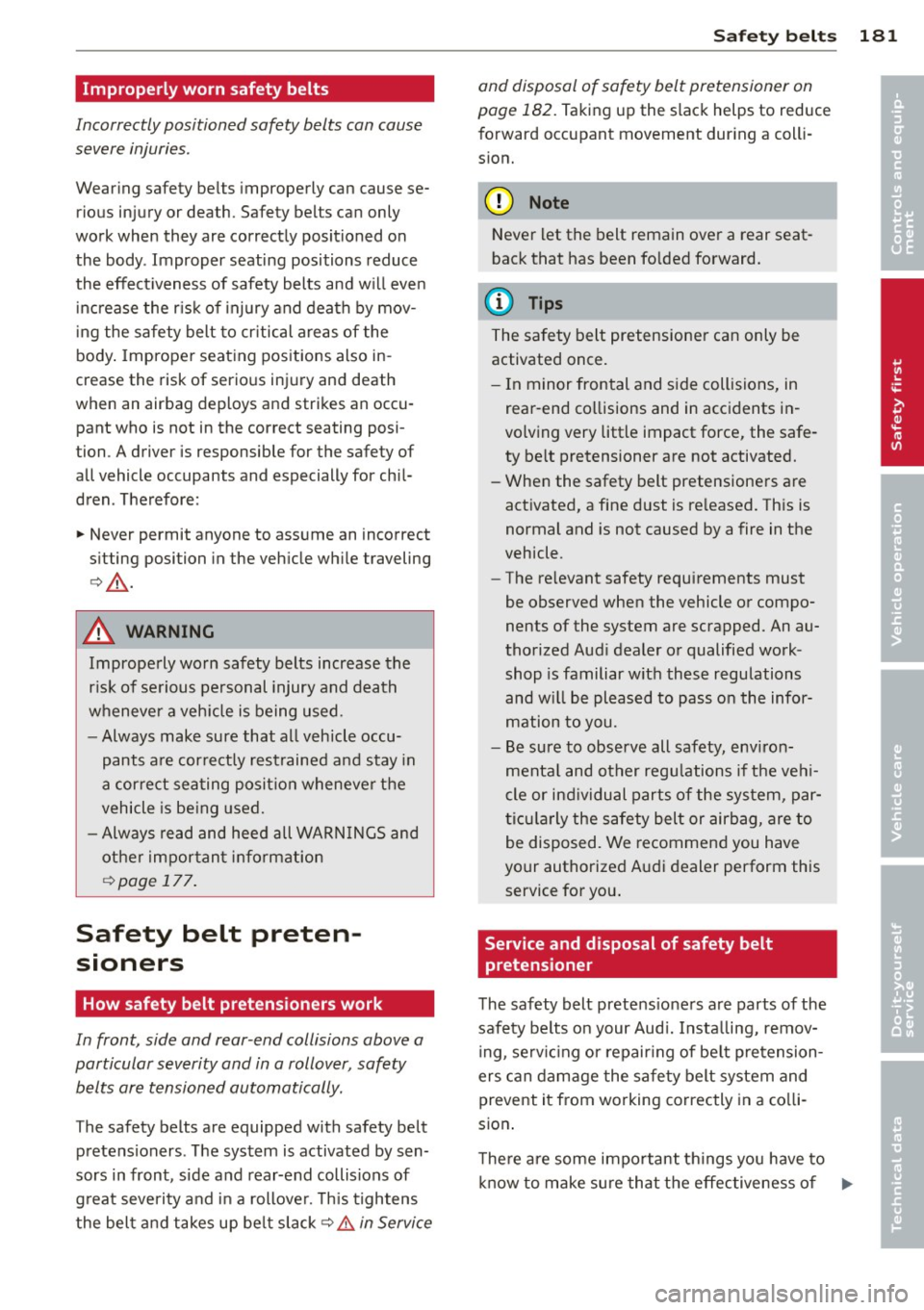
Improperly worn safety belts
Incorrectly positioned safety belts can cause
severe injuries .
Wearing safety belts improperly can cause se
rious injury or death. Safety belts can only
work when they are correctly positioned on the body . Improper seating positions reduce
the effectiveness of safety belts and will even increase the risk of injury and death by mov
ing the safety belt to critical areas of the
body . Improper seating positions also in
crease the risk of serious injury and death
when an airbag deploys and strikes an occu
pant who is not in the correct seating posi
tion . A driver is responsible for the safety of
all vehicle occupants and especially for chil
dren . Therefore:
... Never permit anyone to assume an incorrect
sitting position in the vehicle while traveling
¢ ,& .
A WARNING
Improperly worn safety belts increase the
risk of serious personal injury and death
whenever a vehicle is being used.
- Always make sure that all vehicle occu
pants are correctly restrained and stay in
a correct seating posit ion whenever the
vehicle is be ing used.
- Always read and heed all WARNINGS and
other important information
c:>page 177.
Safety belt preten
sioners
How safety belt pretensioners work
In front, side and rear -end collisions above a
particular severity and in a rollover, safety
belts are tensioned automatically.
The safety belts are equipped with safety belt
pretensioners . The system is activated by sen
sors in front, side and rear-end collisions of
great severity and in a rollover. This tightens
the belt and takes up be lt sla ck
c:> .& in Service
Safety belts 181
and disposal of safety belt pretensioner on
page 182.
Taking up the slack helps to reduce
forward occupant movement dur ing a colli
sion.
@ Note
Never let the belt remain over a rear seat
back that has been fo lded forward.
(D Tips
The safety belt pretensioner can only be
activated once.
- In minor frontal and side collisions, in
rear-end collisions and in accidents in
volving very little impact force, the safe
ty belt pretensioner are not activated.
- When the safety belt pretensioners are
activated, a fine dust is re leased. This is
normal and is not caused by a fire in the
vehicle.
- The re levant safety requirements must
be observed when the vehicle or compo
nents of the system are scrapped. An au
thorized Audi dealer or qualified work
shop is familiar w ith these regulations
and w ill be pleased to pass on the infor
mation to you.
- Be sure to observe all safety, env iron
menta l and other regulations if the veh i
cle or ind ividual parts of the system, par
ticularly the safety belt or airbag, are to
be disposed. We recommend you have
your authorized Audi dealer perform this
service for you.
Service and disposal of safety belt
pretensioner
The safety belt pretens ioners are parts of the
safety belts on your Audi. Insta lling, remov
ing, servic ing or repair ing of belt pretension
ers can damage the safety belt system and
prevent it from working correctly in a colli
s ion .
T he re are some impo rtant things you have to
know to make sure that the effectiveness of .,. •
•
Page 184 of 340
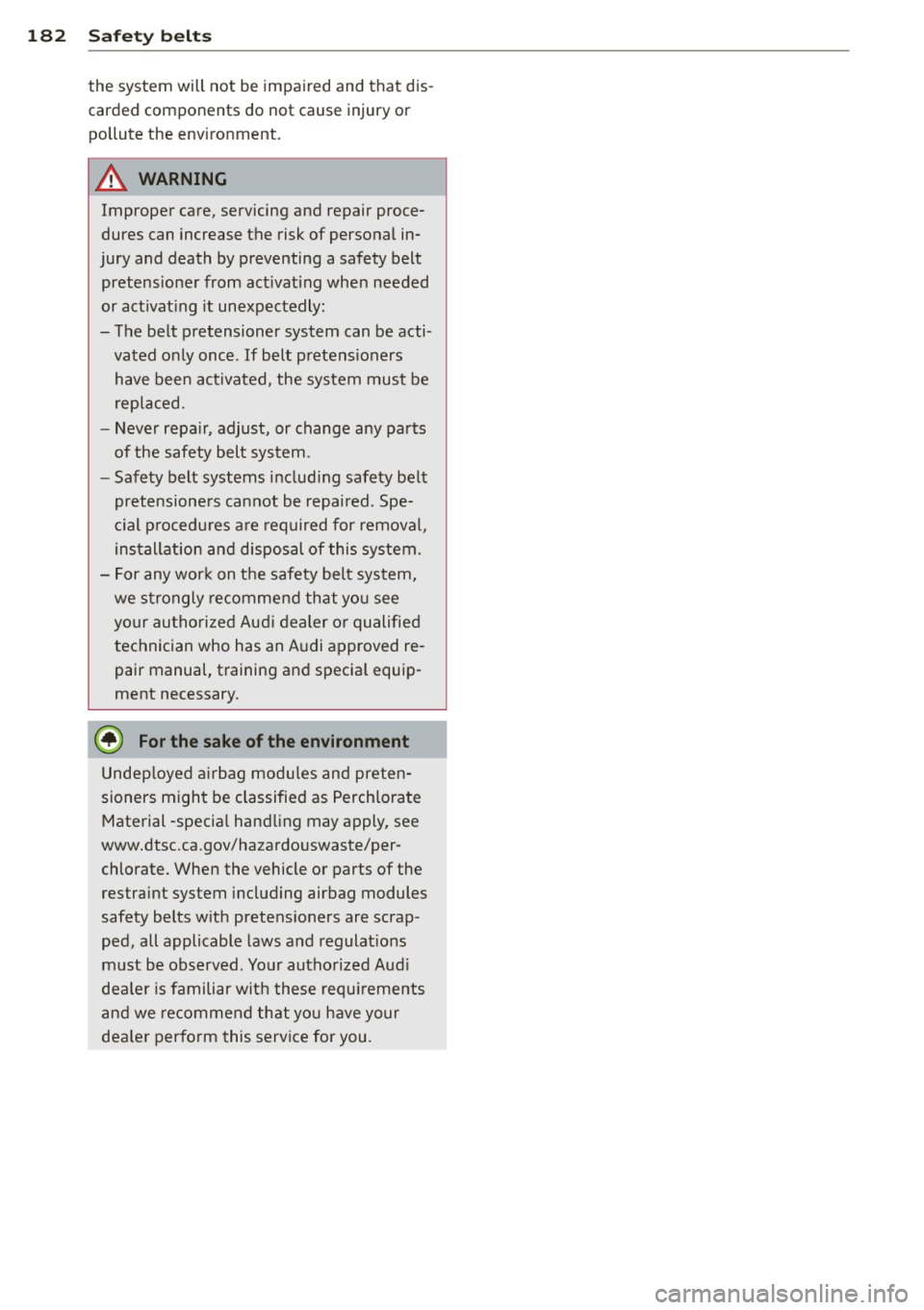
182 Safety belts
the system will not be impaired and that dis
carded components do not cause injury or pollute the environment .
.&_ WARNING
Improper care, servicing and repair proce
dures can increase the risk of personal in
jury and death by preventing a safety belt
pretensioner from activating when needed
or activating it unexpectedly:
- The belt pretensioner system can be acti
vated only once . If belt pretensioners
have been activated, the system must be
replaced.
- Never repair, adjust, or change any parts
of the safety belt system.
- Safety belt systems including safety belt
pretensioners cannot be repaired. Spe
cial procedures are required for removal,
installation and disposal of this system.
- For any work on the safety belt system,
we strongly recommend that you see
your authorized Audi dealer or qualified
technician who has an Audi approved re
pair manual, training and special equip
ment necessary.
@) For the sake of the environment
Undeployed airbag modules and preten
sioners might be classified as Perchlorate
Material -special handling may apply, see
www.dtsc.ca.gov/haza rdouswaste/per
chlorate. When the vehicle or parts of the restraint system including airbag modules
safety belts with pretensioners are scrap
ped, all applicable laws and regulations
must be observed . Your authorized Audi
dealer is familiar with these requirements
and we recommend that you have your
dealer perform this service for you.
Page 185 of 340
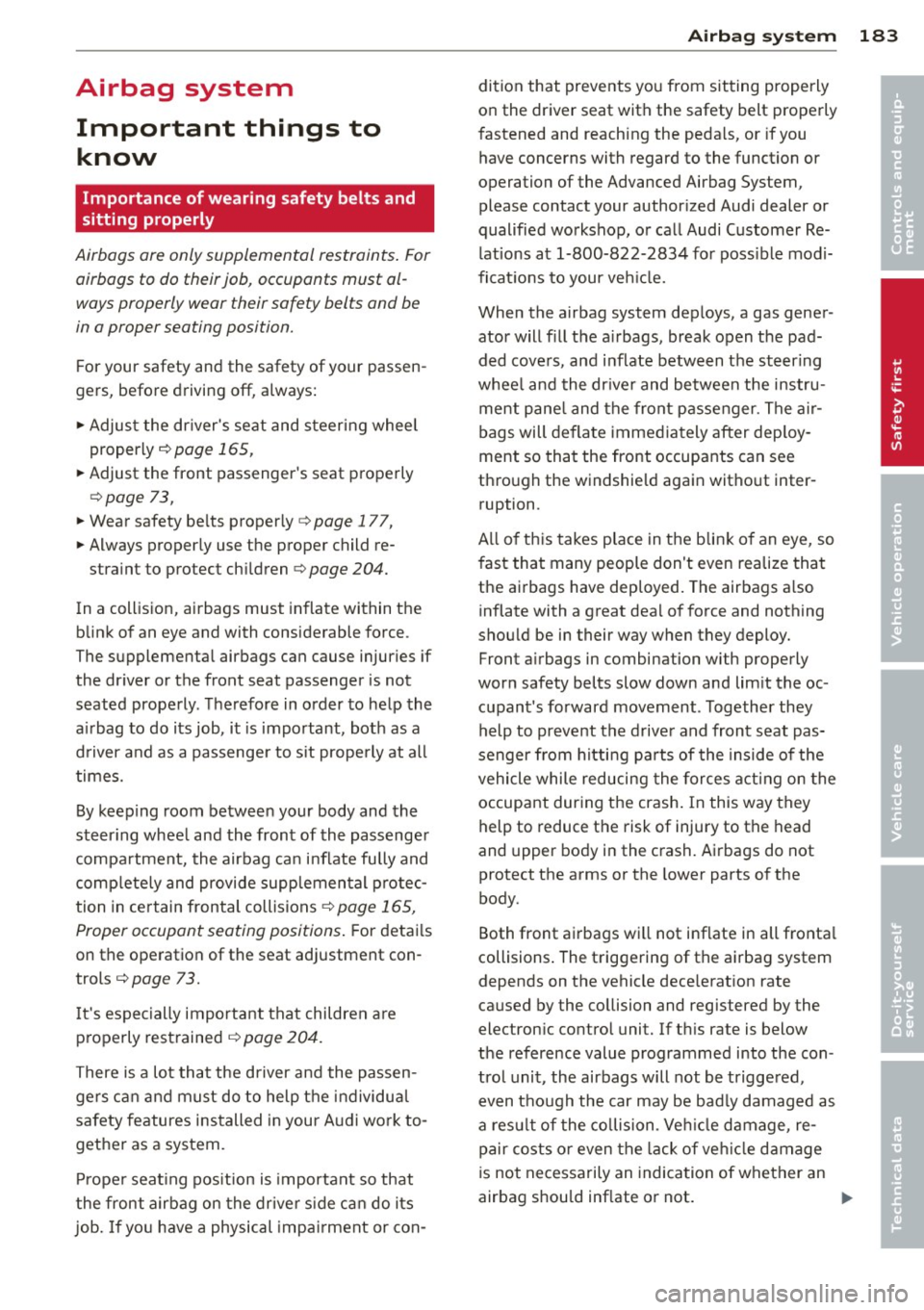
Airbag system Important things to know
Importance of wearing safety belts and
sitting properly
Airbags are only supplemental restraints. For
airbags to do their job , occupants must al
ways properly wear their safety belts and be
in a proper seating position.
For your safety and the safety of your passen
gers, before driving off, always:
"" Adjust the driver's seat and steering wheel
properly
¢ page 165,
"" Adjust the front passenger's seat properly
¢ page 73 ,
""Wear safety be lts properly r::::> page 177,
""Always properly use the proper child re-
straint to protect chi ldren
r::::> page 204.
In a collision, airbags must inflate within the
blink of an eye and with considerable force .
The supplemental airbags can cause injuries if
the driver or the front seat passenger is not
seated properly . T herefore in order to help the
a irbag to do its job, it is important, both as a
driver and as a passenge r to s it properly at all
times.
By keeping room between your body and the
steer ing whee l and the front of the passenger
compartment, the airbag can inflate fully and
comp lete ly and provide supp lemental protec
tion in certain frontal collisions
r::::> page 165,
Proper occupant seating positions.
F or detai ls
on the operation of the seat adjustment con
trols ¢
page 73.
It's especially important that children a re
properly restrained
r::::> page 204.
There is a lot that the driver and the passen
gers can and must do to help the individual
safety features installed in your Aud i work to
gether as a system.
Prope r seat ing pos ition is important so that
the front airbag on the driver side ca n do its
job. If you have a physical impa irment or con-
A irbag system 183
dition that prevents you from sitting properly
on the driver seat with the safety belt properly
fastened and reaching the pedals, or if you
have concerns with regard to the function or
operation o f the Advanced Airbag System,
please contact your author ized Audi dealer or
qualified workshop, or call Audi Customer Re
l ations at 1-800-822-2834 for poss ible modi
ficat io ns to your veh icle.
When the airbag system dep loys, a gas gener
ator will fill the a irbags, break open the pad
ded covers, and inflate between the steer ing
whee l and the dr iver and between the instru
ment panel and the front passenger. The a ir
bags will deflate immediately after dep loy
ment so that the front occupants can see
through the windshield again witho ut inter
ruption .
A ll of th is takes place in the blink o f an eye, so
fast that many people don't even realize that
the airbags have deployed. The airbags a lso
inflate with a great dea l of force and nothing
should be in their way when they deploy.
Front a irbags in combinat ion with properly
worn safety belts slow down and lim it the oc
cupant's forward movement . Together they
help to prevent the driver and front seat pas
senger from h itti ng pa rts of the inside of the
vehicle while reducing the forces acting on the
occupant during the crash . In this way they
help to reduce the risk of injury to the head
and upper body in the crash. Airbags do not
protect the arms or the lower parts of the
body.
Both front airbags will not inflate in all fronta l
collisions . The triggering of the airbag system
depends on the vehicle de ce lerat ion rate
caused by the collision and regis te red by the
elec tron ic control unit. If th is rate is below
the reference value programmed into the con
trol unit, the airbags will not be trigge red,
even though the car may be bad ly damaged as
a res ult of the co llision . Ve hicl e damage, re
pair costs or even the lack of ve hicle damage
is not necessarily an indication of whether an
airbag should inflate or not . •
•
Page 186 of 340
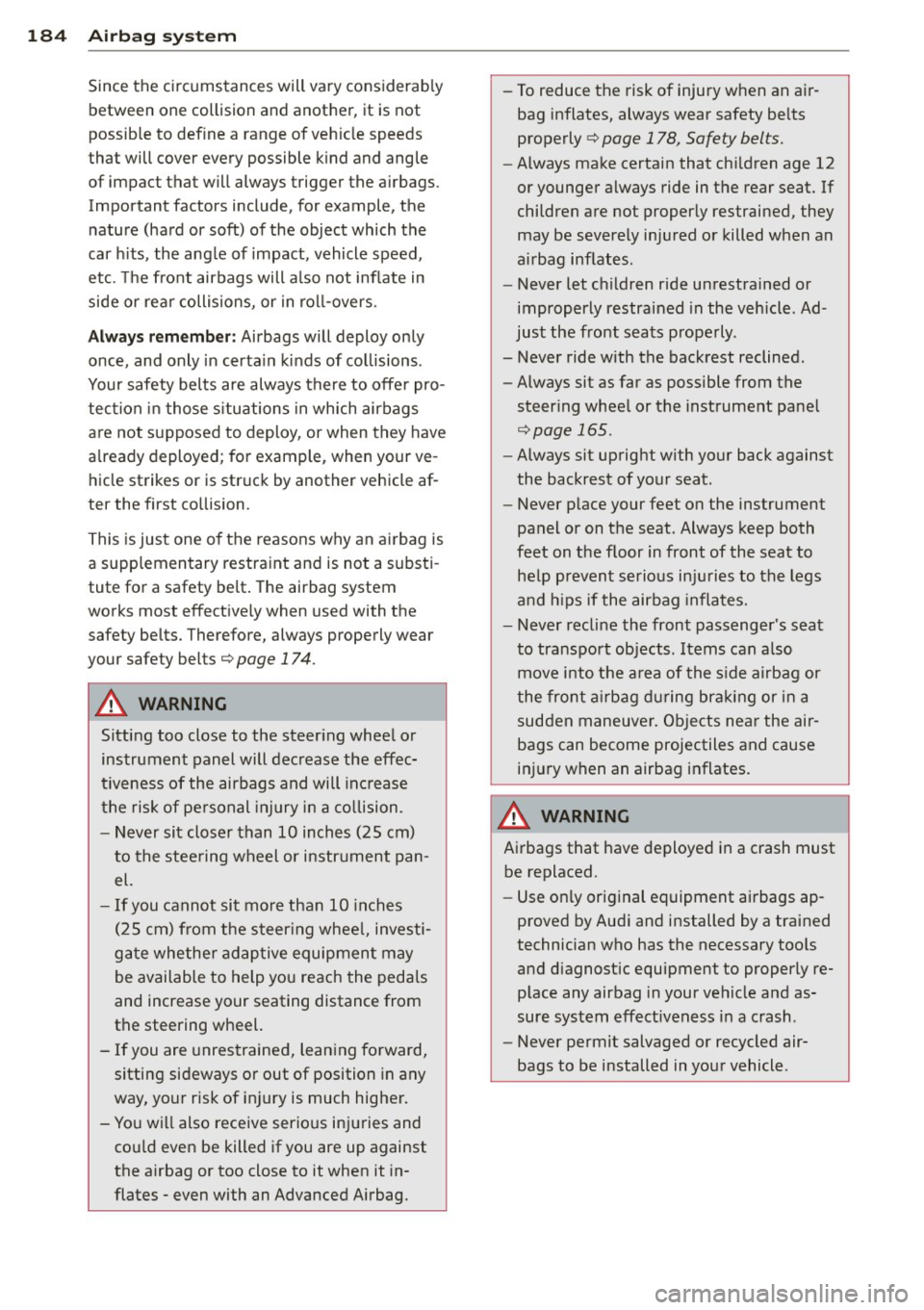
184 Airbag sys tem
Since the cir cumstances will vary considerab ly
between one collision and anot her, it is not
possib le to def ine a range of vehicle speeds
that will cover every possible k ind and angle
of impact t hat will always trigger the a irbags.
Important factors include, for example, the
nature (hard or soft) of the object which the
car h its , the ang le of impact, vehicle speed ,
etc. The front airbags will also not inflate in
side or rea r collisions, or in ro ll-overs .
Always remember : Airbags will deploy only
once, and only in certa in k inds of co llisions .
Your safety belts are always there to offer pro
tection in those s ituations in which airbags
a re not supposed to deploy, or when they have
a lready deployed ; for example , when your ve
hicle strikes or is struck by another vehicle af
te r the first co llision .
This is jus t one of the reasons why an a irbag is
a supplementary restra int and is not a substi
tute fo r a safety belt . The airbag system
works most effect ively when used with the
safety belts. There fore, always properly wear
your safety belts
c::;, page 174 .
A WARNING
Sitting too close to the steer ing whee l or
instrument panel will dec rease the effec
t iveness of the airbags and will increase
the risk of personal injury in a collision .
- Never sit closer than 10 inches (2S cm)
to the stee ring wheel or instrument pan
el.
- If you cannot sit more than 10 inches
( 2 5 cm) from the s teer ing whee l, investi
gate whethe r adap tive equipmen t may
be available to help you reach the pedals
and increase your seating distance from
the steering wheel.
- If you are unrestrained, lean ing fo rward,
sitting sideways or out of position in any
way, your risk of in jury is much higher.
- You will also receive serio us injuries and
cou ld even be killed if you are up against
the airbag or too close to it when it in
flates - even with an Advanced Airbag. -
To reduce the risk of injury when an a ir
bag inflates, always wear safety be lts
properly
c::;, page 178, Safety belts.
- Always make certain that ch ildren age 12
or younger always ride in the rear seat. If
children are not properly restrained, they
may be severe ly injured or killed when an
ai rbag inflates .
- Never let children ride unrestrained or
improperly restrained in the vehicle. Ad
just the front seats prope rly .
- Never ride with the back rest reclined .
- Always sit as far as possible from the
steer ing whee l or the instrument pane l
c::;, page 165.
-Always sit upright with your back against
the backrest of your seat .
- Never p lace your feet on the instrument
panel or on the seat. Always keep both
feet on the floor in front of the seat to
help prevent serio us in ju ries to the legs
and h ips if the airbag inflates.
- Never recline the front passenger 's seat
to transport objects , Items can a lso
move into the a rea of the s ide airbag or
the front a irbag du ring bra king or in a
sudden maneuve r. Objects nea r the air
bags can become projectiles and cause
in jur y when an airbag inflates.
A WARNING ~
Airbags that have deployed in a crash must
be replaced.
- Use on ly orig ina l equipment airbags ap
proved by Aud i and installed by a trained
technician who has the necessary too ls
and d iagnost ic equipment to properly re
p lace any airbag in your vehicle and as
sure system effectiveness in a crash .
- Never permit salvaged or recycled air
bags to be installed in your vehicle .
Page 187 of 340
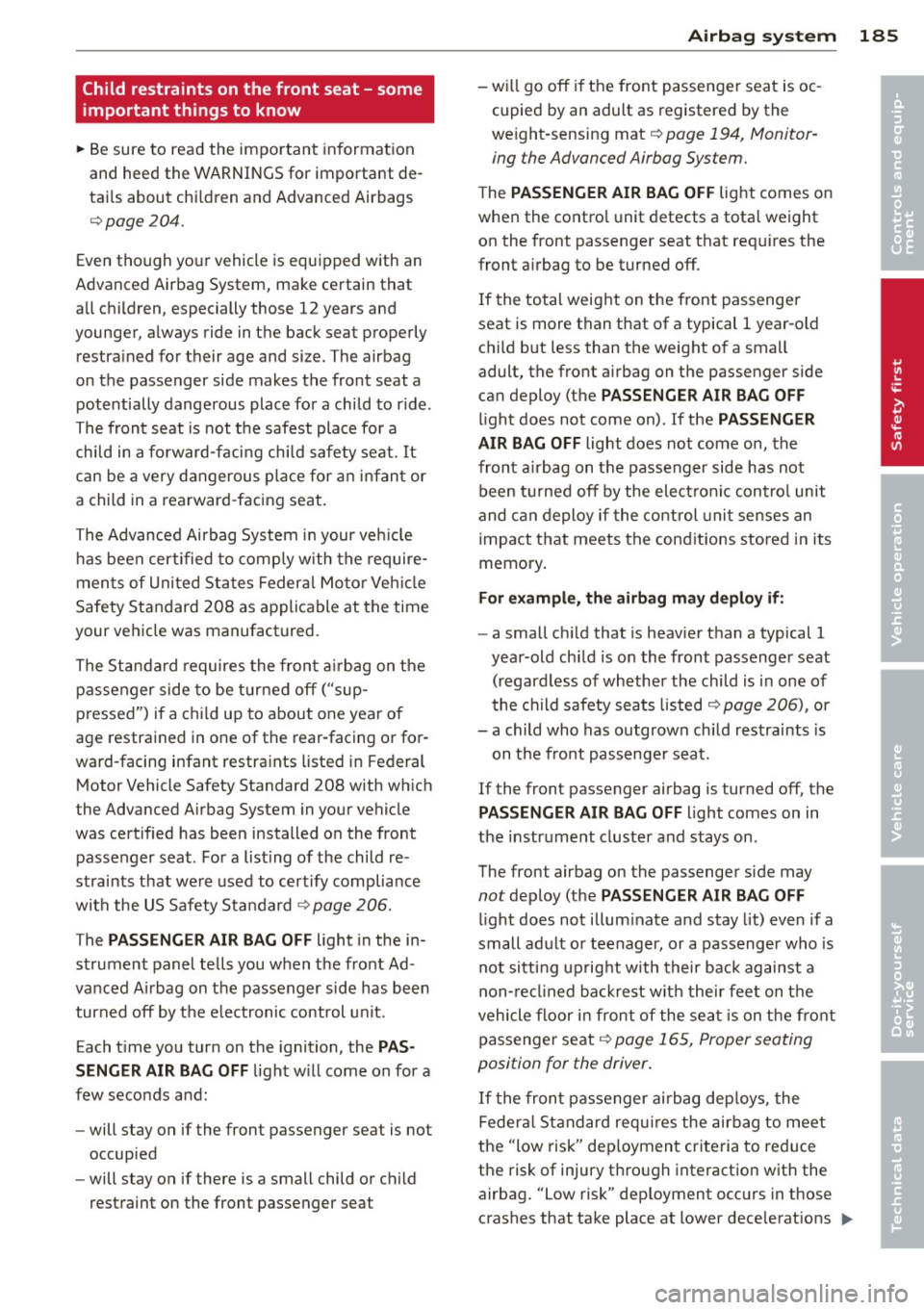
Child restraints on the front seat - some
important things to know
.. Be sure to read the important informat ion
and heed the WARNINGS for important de
tai ls about chi ldren and Advanced Airbags
c> page 204.
Even though your vehicle is equipped with an
Advanced Airbag System, make certain that
a ll chi ldren, especially those 12 years and
younger, a lways ride in the back seat properly
restra ined for their age and size. The airbag
on the passenger side makes the front seat a potentially dangerous place for a child to r ide .
The front seat is not the safest place fo r a
chi ld in a fo rward-facing chi ld safety seat. It
can be a very dangerous place for an infan t or
a child in a rea rward -facing seat.
The Advanced Airbag System i n your veh icle
h as been cert ified to comp ly with the require
men ts of Uni ted States Federa l Mo to r Veh icle
Safety Standard 208 as applicable at the time
your ve hicle was manufactured.
The Standard requires the fron t air bag on the
passenger side to be turne d off ("sup
p ressed") if a chi ld up to about one year of
age restrained in one of the rear -facing or for
ward -facing infant restraints listed i n Federal
Motor Vehicle Safety Standard 208 with wh ich
the Advanced Airbag System in your vehicle
was certified has been installed o n the front
passenger seat. For a listing of the child re
straints that we re used to certify compliance
with the US Safety Sta ndard
c> page 206.
The PASS ENGER AIR BAG OFF light in the in
strument panel te lls you when the front Ad
vanced A irbag on the passenger side has been
turned off by the e lectronic control u nit.
Each t ime you tur n on the ignition, the
PAS
SENGER AIR BAG OFF
l ight w ill come on for a
few seconds a nd:
- will stay on if the front passenger seat is not
occup ied
- will stay on if there is a small child or child
restraint on the front passenger seat
A irbag sys tem 185
- will go off if the front passenger seat is oc
cupied by an adult as registered by the
weight -sensing mat
c> page 194, Monitor
ing the Advanced Airbag System.
T he PASSENGER AIR BAG OFF light comes on
whe n the contro l unit detects a tota l weight
on the front passenger seat that req uires the
front a irbag to be turned off.
If the total weight on the front passenge r
seat is more than that of a typical 1 year-o ld
c h ild but less than the weight of a small
adult, the front airbag on the passenger side
can deploy (the
PASSENGER AIR BAG OFF
li ght does not come on). If the PASSENGER
AIR BAG OFF
light does not come on, the
front a irbag on t he passeng er side has not
been turned off by the elec troni c con trol unit
and can deploy if the control unit senses an
impact that meets the cond it ions stored i n its
memory .
For example, th e airb ag may deploy if :
-a small ch ild that is heav ie r than a typical 1
year-old ch ild is o n the front passenger seat
(regard less of whether the child is in one of
the ch ild safety seats listed
c> page 206), or
- a child who has outgrown chi ld restraints is
on the front passenge r seat.
If the front passenger airbag is turned off, the
PASSENGER AIR BAG OFF light comes on in
the instr ument cluster and stays on .
The front airbag on the passenger side may
not deploy (the PASSENGER AIR BAG OFF
l ight does not illum inate and stay lit) even if a
small ad ult o r teenager, or a passenger who is
not sitti ng uprig ht w ith their back against a
non -recli ned back rest w it h thei r feet on t he
vehicle floor i n front of the sea t is on t he front
passenger seat
c> page 165, Proper seating
position for the driver.
If the fron t passenger ai rbag dep loy s, the
Feder al Standard req uires the airbag to meet
the "low risk" dep loyment criteria to reduce
the ris k of injury t hro ugh interact ion w ith the
airbag. "Low risk" dep loyment occ urs in those
crashes that take place at lower dece lerat ions ..,_ •
•
Page 188 of 340
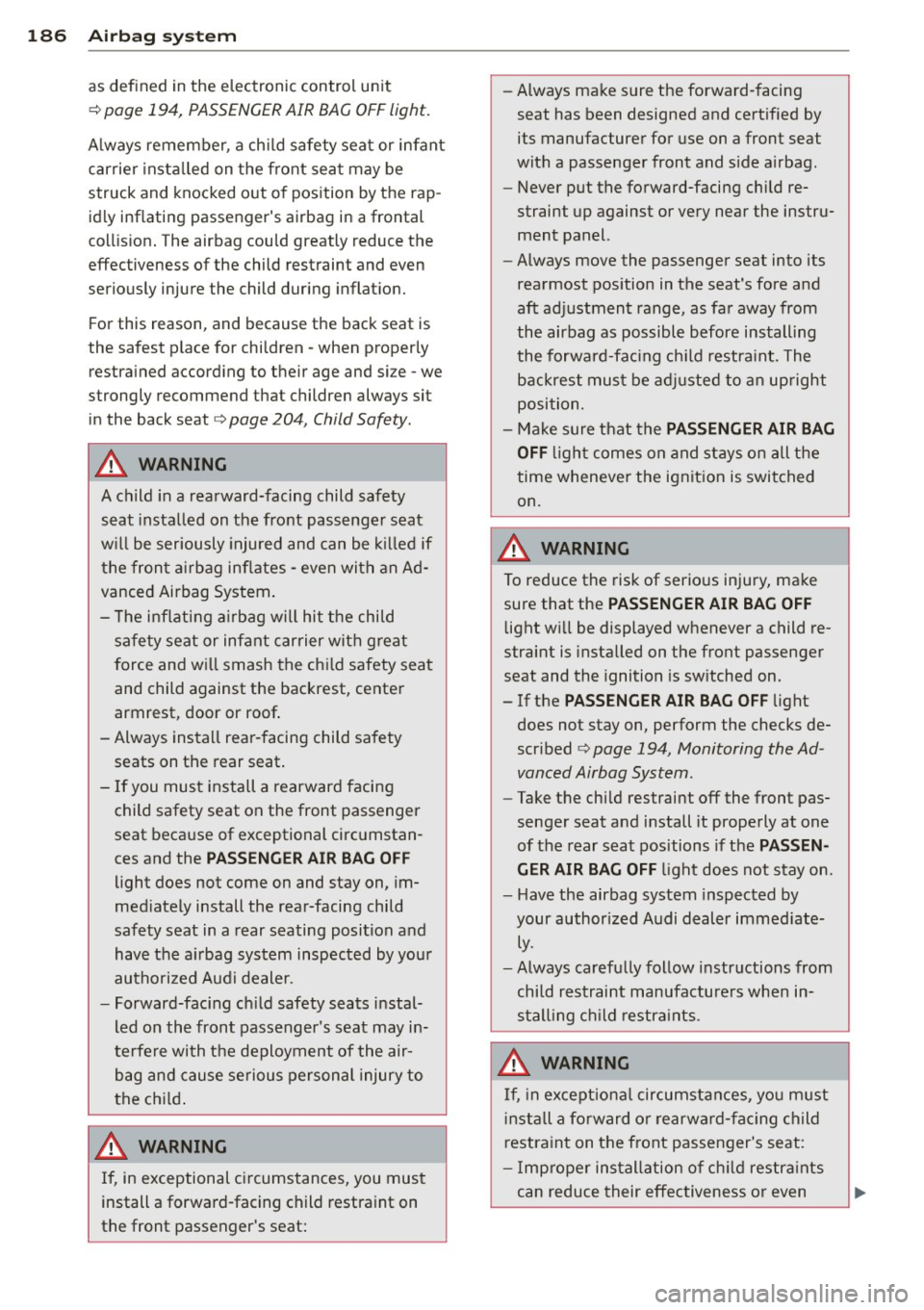
186 Airbag sys tem
as def ined in the electronic control unit
Q page 194, PASSENGER AIR BAG OFF light.
A lways remember, a ch ild safety seat or infant
carrier insta lled on the front sea t may be
struck and knocked o ut o f position by the rap
id ly inflating passeng er's airbag in a frontal
coll is ion . T he airbag cou ld greatly reduce the
effec tiveness of the child restraint and even
serious ly injure the child during inflat ion.
F or this reason, and because the back seat is
the safest p lace for children - when properly
restra ined acco rd ing to their age and si ze - we
s trongly recommend that children always sit
in the back seat
Q page 204, Child Safety .
A WARNING
A child in a rearward-facing child safety
s e at insta lled on the front passenger seat
w ill be seriously injured and can be k illed if
t he fr ont a irbag inflates - even with an Ad
vanced Airbag System.
- T he i nflating a irbag will hit the child
safety seat or infant carrier wit h great
f orce and w ill smash the ch ild safety sea t
and child against the backrest , center
armrest, door or roof.
- Always insta ll rear -facing child sa fety
seats on the rear seat.
- If you mus t install a rearward facing
child safety seat on the front passenger
seat because of exceptional circ umstan
ces and the
PASSENG ER AIR BAG OFF
light does not come on and stay on , im
med iately install the rea r-facing child
safety seat in a rear seating position and
hav e the a irbag system inspected by you r
authori zed Aud i dealer.
- Forward-fac ing ch ild safety seats instal
led on the front passenger's seat may i n
terfere wi th the deployment of the air
b ag and cau se serious person al injury to
the ch ild .
A WARNING
If, in exceptional c ircumstances, you must
install a forward-facing child restra int on
the front passenger's seat: -
Always make sure the forward-facing
seat has been designed and certified by
its manufacturer for use on a front seat
with a passenger front and s ide a irbag .
- Never put the forward-facing child re
straint up against or very near the instru ment panel.
- Always move the passenger seat into its
rearmost pos ition in the seat's fore a nd
aft ad justment range, as fa r away from
the airbag as possible b efore installing
the forwa rd-fa cing ch ild restra int. The
b ackrest mus t be a djusted to a n up right
position.
- Make s ure that the
PASSENGER AIR BAG
OFF
li ght comes on and stays o n all the
t ime wheneve r the ignition is switched
on.
A WARNING -ra----
To reduce the risk of serious injury, make
sure that the
PASSENGER AIR BAG OFF
light will be displayed whenever a child re
straint is installed on the front passenger
seat and the ignition is sw itched on.
- If the
PASSENGER AIR BAG OFF light
does not stay on, perform the checks de
scribed
Q page 194, Monitoring the Ad
vanced Airbag System .
-Take t he chi ld restraint off the front pas
senger seat and install it prope rly at one
of the rear seat positions if t he
PASSEN
GER AIR BAG OFF
li ght does not stay on.
- Have the airbag system inspected by
your author ized Audi deal er immed iate
ly .
- Always carefu lly follow instr uctions from
chi ld restraint manufacture rs when in
st all ing c hild restra ints .
A WARNING
If, in exce ptiona l circumstances, you m ust
i nsta ll a forward or rearw ard-fa cing child
r estra int on the front passenger's seat :
- Imp roper ins tallation o f child restra ints
can reduce their effec tiveness or even
Page 189 of 340
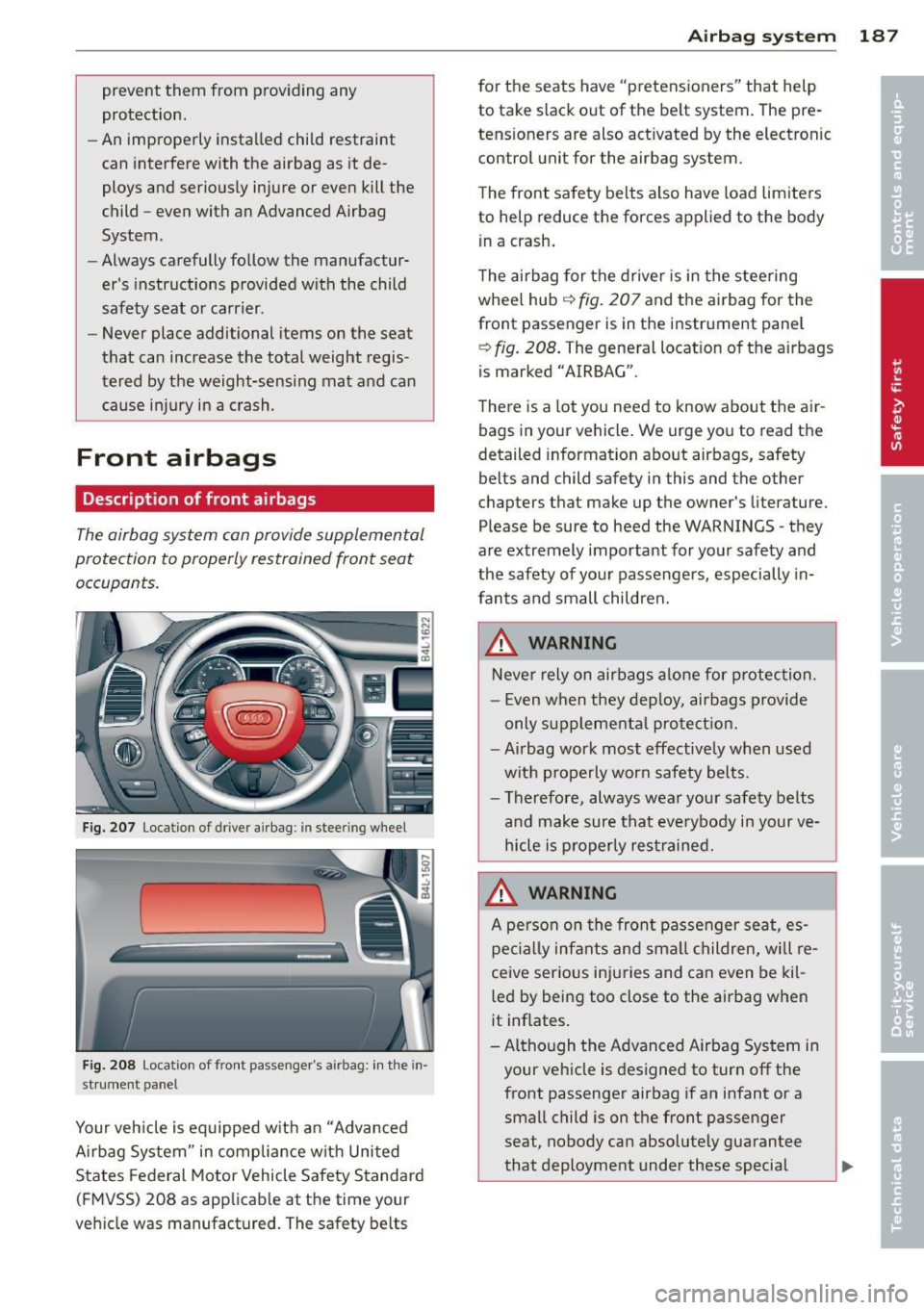
prevent them from providing any
protection.
- An improperly installed child restraint
can interfere with the airbag as it de
ploys and seriously injure or even kill the
child -even with an Advanced Airbag
System.
- Always carefully follow the manufactur
er's instructions provided with the child
safety seat or carrier.
- Never place additional items on the seat
that can increase the total weight regis
tered by the weight-sensing mat and can cause injury in a crash.
Front airbags
Description of front airbags
The airbag system can provide supplemental
protection to properly restrained front seat
occupants.
Fig. 207 Location of driver ai rb ag : in stee ring whee l
Fig. 208 Location of front passenger 's a irbag: in the in
strume nt panel
Your vehicle is equipped with an "Advanced
Airbag System " in compliance with United
States Federal Motor Vehicle Safety Standard
(FMVSS) 208 as applicable at the time your
ve hicle was manufactured. The safety belts
Airbag system 187
for the seats have "pret ens ioners " that help
to take slack out of the belt system. The pre
tensioners are also activated by the electronic
control unit for the airbag system.
Th e front safety belts also have load limiters
to help reduce the forces applied to the body
in a crash .
Th e airbag for the driver is in the steering
wheel hub
q fig. 207 and the airbag for the
front passenger is in the instrument panel
~ fig. 208. The general location of the airbags
is marked "AIRBAG" .
There is a lot you need to know about the air
bags in your vehicle. We urge you to read the
detailed information about airbags, safety
belts and child safety in this and the other
chapters that make up the owner's literature.
Please be sure to heed the WARNINGS -they
are extremely important for your safety and
the safety of your passengers, especially in
fants and small children.
_&. WARNING
Never rely on airbags alone for protection.
- Even when they deploy, airbags provide
only supplemental protection.
-Airbag work most effectively when used
with properly worn safety belts.
- Therefore, always wear your safety belts
and make sure that everybody in your ve
hicle is properly restrained.
_&. WARNING
A person on the front passenger seat, es
pecially infants and small children, will re
ceive serious injuries and can even be kil
led by being too close to the airbag when
it inflates.
- Although the Advanced Airbag System in
your vehicle is designed to turn off the
front passenger airbag if an infant or a
small child is on the front passenger
seat, nobody can absolutely guarantee
that deployment under these special
11>-
Page 190 of 340
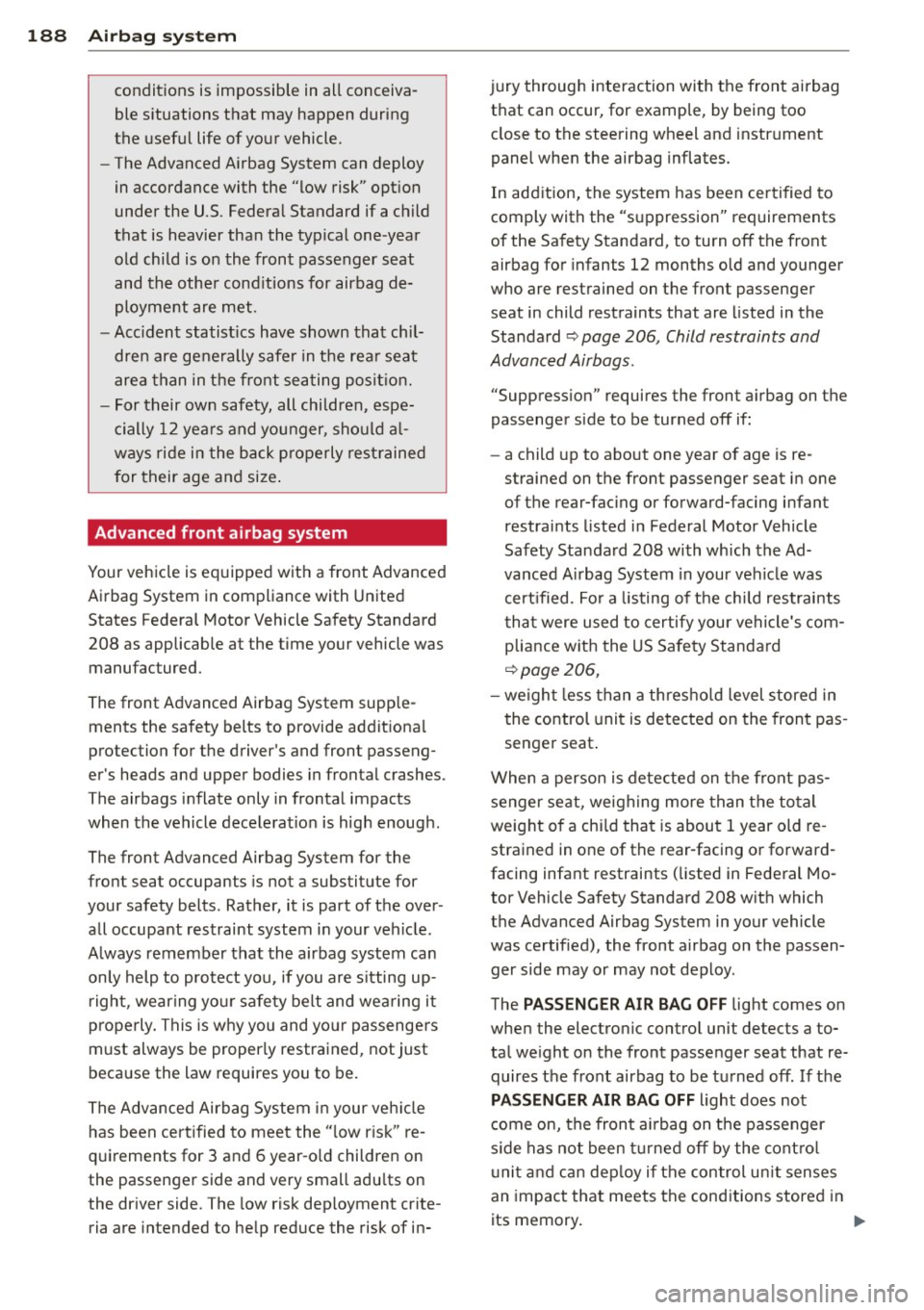
188 Airbag system
conditions is impossible in all conceiva
ble situations that may happen during
the useful life of your vehicle.
- The Advanced Airbag System can deploy
in accordance with the "low risk" option
under the U.S. Federal Standard if a child
that is heavier than the typical one-year
old child is on the front passenger seat
and the other conditions for airbag de
ployment are met.
-Accident statistics have shown that chil
dren are generally safer in the rear seat
area than in the front seating position.
- For their own safety, all children, espe
cially 12 years and younger, should al
ways ride in the back properly restrained
for their age and size.
Advanced front airbag system
Your vehicle is equipped with a front Advanced
Airbag System in compliance with United
States Federal Motor Vehicle Safety Standard
208 as applicable at the time your vehicle was
manufactured.
The front Advanced Airbag System supple ments the safety belts to provide additional
protection for the driver's and front passeng
er's heads and upper bodies in frontal crashes .
The airbags inflate only in frontal impacts
when the vehicle deceleration is high enough.
The front Advanced Airbag System for the
front seat occupants is not a substitute for
your safety belts. Rather, it is part of the over
all occupant restraint system in your vehicle.
Always remember that the airbag system can
only help to protect you, if you are sitting up
right , wearing your safety belt and wearing it
properly. This is why you and your passengers
must always be properly restrained, not just
because the law requires you to be.
The Advanced Airbag System in your vehicle has been certified to meet the "low risk" re
quirements for 3 and 6 year-old children on
the passenger side and very small adults on
the driver side. The low risk deployment crite
ria are intended to help reduce the risk of in- jury through interaction with the front airbag
that can occur, for example, by being too close to the steering wheel and instrument
panel when the airbag inflates.
In addition, the system has been certified to
comply with the "suppression" requirements
of the Safety Standard, to turn off the front
airbag for infants 12 months old and younger
who are restrained on the front passenger
seat in child restraints that are listed in the Standard
~ page 206, Child restraints and
Advanced Airbags .
"Suppression" requires the front airbag on the
passenger side to be turned off if:
- a child up to about one year of age is re
strained on the front passenger seat in one
of the rear-facing or forward-facing infant
restraints listed in Federal Motor Vehicle
Safety Standard 208 with which the Ad
vanced Airbag System in your vehicle was
certified. For a listing of the child restraints
that were used to certify your vehicle's com
pliance with the US Safety Standard
~page 206,
-weight less than a threshold level stored in
the control unit is detected on the front pas
senger seat.
When a person is detected on the front pas senger seat, weighing more than the total
weight of a child that is about 1 year old re
strained in one of the rear-facing or forward
facing infant restraints (listed in Federal Mo
tor Vehicle Safety Standard 208 with which
the Advanced Airbag System in your vehicle
was certified), the front airbag on the passen ger side may or may not deploy.
The
PASSENGER AIR BAG OFF light comes on
when the electronic control unit detects a to
tal weight on the front passenger seat that re quires the front airbag to be turned off. If the
PASSENGER AIR BAG OFF light does not
come on, the front airbag on the passenger
side has not been turned off by the control
unit and can deploy if the control unit senses
an impact that meets the conditions stored in
its memory.
ll-